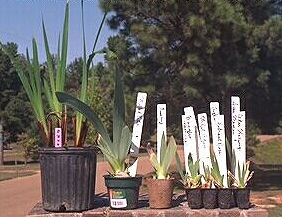By Griff Crump
Not all good results come from planning. Sometimes, they are just gifts. But in either case, we should be grateful.
Looking around among my seedlings, I find instances of both, sometimes in combination.
When I first saw
'Lumalite' (J. T. Aitken, R. 1995) at an iris show, I was so taken by its glowing appearance that, with the exhibitor's permission, I took it outside into the daylight to see if the effect lasted.
'Lumalite'
I acquired it as soon as I could, and crossed it with, among others, 'What, Again?'.
'What, Again?'
I confess that I had no plan at this point -- just curiosity to see what the glowing effect of one combined with the curious color composition of the other would produce. What I got was a gift:
'Elfin Sentinel'.
'Elfin Sentinel'
I was delighted with the flower and registered it, but it had a shortcoming (literally) that caused me not to introduce it: The bloom barely topped its foliage. Looking at its brilliant colors and clear patterning, however, I wondered what a back-cross to its parent
'Lumalite' would bring. For one thing, I wondered if the slight blotchiness of
'Lumalite''s falls could be erased. And it worked! The new seedling retained
'Lumalite''s glowing heart, cleaned up the falls almost entirely, and added ruffles. I introduced it as
'Bright Sprite'.
'Bright Sprite'
'Tis said that ignorance is bliss. I can attest to that. At a meeting of one of our iris societies several years ago, two good long-time hybridizers of my acquaintance were discussing the rebloomer
'Best Bet' (Schreiner's 1988) and the difficulty of keeping it alive (at least, in our area). Both agreed that they would never use it in hybridizing, because of that fault. I said nothing, since I already had a cross from
'Best Bet' that hadn't yet bloomed. When it did bloom, it was a perky, hardy little border bearded amoena that, because of its colors and its parent's unhappy reputation, I registered as
'Against the Tide'.
'Against the Tide'
Because of 'Against the Tide''s hardiness, I never feared to use 'Best Bet' in my breeding, and it is in the background of a number of my introductions, including 'Deep Purple Dream', the rebloomer 'Haunting', Ranks of Blue', 'Royal Pageantry' and a very prolific 2013 offering, 'Night Bird':
'Deep Purple Dream'
'Haunting'
'Ranks of Blue'
'Royal Pageantry'
'Night Bird'
And if one looks in the Iris Register at the 64 other entries involving 'Best Bet', it's obvious that many other hybridizers, as well, were either unaware of or undaunted by 'Best Bet''s bad press.
Another example of when the planning worked was the crossing of Barry Blyth's 'Knighted' (1987/88) with seedling 962N: (952Y3: (Champagne Elegance x 93L1: (Wabash x yellow Wabash sdlg.)) x Best Bet).
'Knighted'
With strong amoena heritage on both sides of this cross, I looked for an amoena outcome, and wasn't disappointed. Besides 'Royal Pageantry', which we have seen above, a near twin, Seedling 02S2, was produced. I hesitated to introduce two such similar flowers, but have reconsidered, since garden visitors want it. So, I plan to introduce it shortly. Two photos of 02S2 follow:
Sdlg 02S2
Of course, a plan doesn't always work. I had great hopes for the cross of '
Aura Light' (Blyth, R. 1993) by
'Romantic Evening' (Ghio, R. 1994). The broad, flared, well-ruffled falls of both, with their heavy substance and bold colors, and the heritages suggesting the possibility of an amoena . . .
'Aura Light'
'Romantic Evening'
. . . and yes! The cross produced amoenas 01S2 and 01S3, so alike that I can only tell them apart by keeping their plantings well separated, with rich, overlapping broad mahogany red falls ---
Sdlg 01S2
Sdlg 01S3
--- BUT . . . 'Aura Light', for all its spectacular bloom beauty, is just a tad short in stature, and it passed it on to its kids, so that, in my estimation, these two seedlings don't have quite the proportion of height to bloom size that they should have for introduction. But, with planning and and a bit more luck, do I hope that they'll still figure in something beautiful? You betcha!











.JPG)














.jpg)






+reduc.jpg)
+reduc.jpg)




